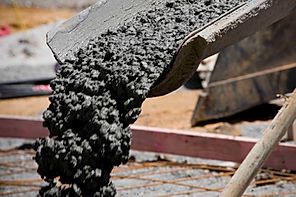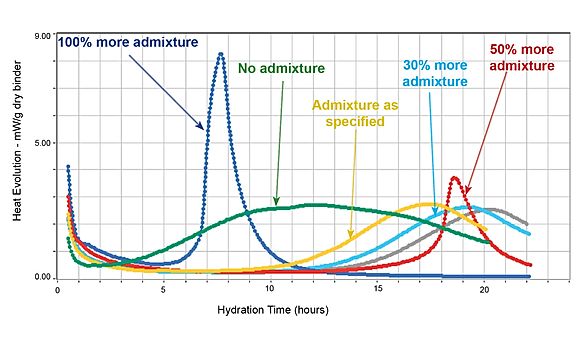Calorimetry applied to Cement & Concrete Technology
Accelerate research for sustainable cement, admixture formulation, quality control in cement and concrete production, mix designs, etc.
Overview

Calorimetry measures the heat generated from the early hydration of cementitious materials. The measurement of the reaction rate in a caloirmerer is continuous and in real time, giving visibility into the behavior of cement paste, concrete or mortar in a way that traditional testing such as set time or compressive strength tests could not.
The timing and shape of the temperature or heat curves obtained through calorimetry is an indicator of relative performance of cementitious mixes, and of potential adverse interactions among materials used in the mix.
Calmetrix manufactures two types of calorimeters for applications related to cement:
-
semi-adiabatic calorimeters, in which concrete samples are in a well insulated environment, simulating hydration at the core of a mass concrete application, and
-
isothermal calorimeters, in which the temperature around a paste or mortar sample is maintained constant to simulate different curing temperatures. The temperature control further allows for excellent repeatability.
Typical uses of calorimetry can be found in:
-
Research and Development
-
Admixture formulation
-
Characterization of Supplementary Cementitious Materials
-
Evaluation of new materials, ...
-
-
Mix Design Optimization
-
Compare mixes using different sources of cement
-
Compare different brands or types of admixtures
-
Compare mixes with various Fly Ash or Slag sources. Look for compatibility.
-
Test the effect of different admixture addition times (upfront in mixing water or delayed), ...
-
-
Troubleshooting, Quality Control and Performance Limits
-
Determine the maximum dose of an admixture with a given cement before performance gets affected. Especially recommended for high performance concrete.
-
Help determine the optimum dosage of admixtures or Supplementary Materials with different cements (see example on the right)
-
Spot potential problems of adverse material interaction
-
Sulfate Optimization and quality control at the cement plant level, ...
-
-
Performance Prediction
-
Use calorimetry curves to infer compressive strength
-
Investigate failure modes based on statistical analysis / mix tracking
-
Calculate the Activation Energy and predict thermal cracking.
-
Use thermal indicators to infer setting
-
Example of test conducted in an I-Cal 8000

This example shows the sensitivity to changes in admixture dosage. The graphic shows the Heat Evolution from the hydration reaction (in mW/g of dry cement) over time.
The yellow curve represents a standard mix including a normal dose of a water reducing admixture. A 30% overdose of admixture (light blue) does not show any issues, other than a two-hour retardation. A 50% admixture overdose (red curve) shows both severe retardation and altered shape of the main hydration peak. At 100% admixture overdose (dark blue curve), the steep rise and high peak are indicators of an uncontrolled aluminate reaction, with poor ensuing strength gain.
